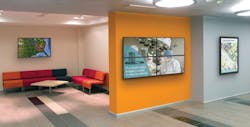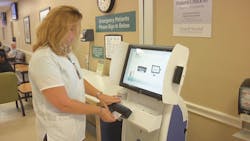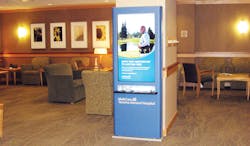Wayfinding more than a question of convenience
After the massive funnel cloud slithered through Joplin, MO, eight years ago, the thick, swirling spire of rotating winds destroying virtually everything within its path, the leaders at Mercy’s St. John’s Regional Hospital needed a way to communicate with staffers scattered throughout the area, some of whom already launched dutifully into rescue mode.
Amid city-wide power outages, downed telephone lines and spotty, unreliable mobile phone signal transmissions in relatively close proximity of the fatally damaged hospital, Mercy executives opted for something more rudimentary but effective. Think of it as an electronic version of smoke signals: Battery-powered digital signage.
“The digital signs were used as a way to connect with our own Mercy Joplin co-workers in the days following the tornado, since normal communications channels were disrupted, and co-workers didn’t have a workplace to report to,” recalled Barb Meyer, Vice President, Communications, Mercy’s Integrated Marketing office. “We used the digital signs along major roads in Joplin to ask co-workers to contact us and advise us of their status. We directed them to a [working] phone line and/or the newly-established Mercy command center at the Holiday Inn Convention Center in Joplin, so that we could account for their safety and status, determine their needs — including housing, transportation — connect them with resources as needed, and establish how best to stay in contact with them to provide updates on returning to work, options for other Mercy employment, etc.”
Editor’s Note: For earlier reporting on the Joplin disaster, click here: https://cdn.hpnonline.com/inside/2012-01/1201-PS-Disaster.html and here: https://cdn.hpnonline.com/inside/2013-10/1310-UpClose2.html.
One of the more frustrating challenges a patient or visitor experiences in a healthcare facility begins the moment he or she walks through the front door: How to get where they need to go.
Some might say that frustration starts even before that, such as where to park — especially during construction/renovations or after some crisis — and which door is where you need to enter? During a crisis or disaster, such digital aides can provide direction, hope, instructions and some semblance of order needed during chaos.
That’s where digital signage and kiosks come into play.
Through these wall- or floor-mounted or free-standing flat-screen monitors, computers and even vending equipment, patients, business associates and visitors alike can get directions and layouts, check in/out and schedule appointments and reduce stress levels already heightened from being late, feeling lost and otherwise helpless.
Short of staffing a help desk, these digital assistants typically don’t operate on labor shifts. And they don’t need breaks. Unless the system is down for some reason (e.g., maintenance, malfunction or power outage) they’re always on, primed and ready to guide and help you.
Digital derby
A growing number of hospitals and other healthcare organizations are recognizing what hotels and office buildings do about the usefulness of digital signage and kiosks to maneuver human traffic. While these technologies are not yet pervasive and universal beyond the most forward-thinking facilities, they are generating interest for a variety of valuable uses.
“While most healthcare kiosks and digital signage are designed to simplify tasks and remove the administrative burden from healthcare professionals, they can take on a multitude of tasks, some of which include patient check-in, EMR management, wellness tracking and digital directories,” said Melissa Tally, Marketing Coordinator, Meridian Kiosks, Aberdeen, NC.
Tally highlights four areas where digital signage and kiosks should pique interest and Supply Chain exploration.
Patient Check-In. “Digital check-in kiosks allow patients to bypass the traditional check-in process at the administration desk,” Tally noted. “In doing so, patients are able to check in, confirm insurance information, and electronically sign documents, all from the digital kiosk.”Nicholas Van Zandt, Director, Channel Sales, Phunware, Austin, TX, points to patient and visitor experience affecting satisfaction scores that impact reimbursement as motivation.
“Hospitals can be confusing places,” Van Zandt told Healthcare Purchasing News. “Over the years they have grown in size, expanded their campus reach, and presented staff, patients and visitors with increasing challenges with navigating the facility and finding what they need. Digital signage and kiosks that can serve as a utility to staff and visitors to assist them with how they engage with the property will be key to ensuring a positive experience and efficiency in operations.”
Van Zandt describes a patient’s electronically eased journey inside a facility: “Patients visiting healthcare facilities will need to first find their way to their designated physician’s office or department, and once they are there, they will need to complete a check-in process. Digital signage and kiosks can help streamline that process,” he noted. “When a patient arrives, they can check in at the kiosk where they’ll be able to interact with the scheduling and patient portal system to let their provider know they have arrived and provide any additional information necessary for their appointment.
“Once the check-in is complete, the patient can then be provided with the route for them to follow,” Van Zandt continued. “This will allow their provider to be ready for the patient when they arrive at their office without any undue delays as part of waiting on them to complete their paperwork, while also ensuring the patient does not get lost in the larger facility, thus creating further delay. This can help decrease the chances of patient no-shows or missed appointments, which impacts revenues, while improving the overall patient experience.”
Increasing patient satisfaction scores can have a direct effect on reimbursements and revenues, Van Zandt insists. “Ensuring an easy journey to find your way, and easy check-in in the hospital can make a big difference in this aspect,” he added.
Such digital wayfaring technology extends beyond the scheduling and check-in processes, according to Stan Swiderski, NEC Display’s National Account Manager, Vertical Sales — Healthcare.
“In clinical settings, digital signage displays are valuable as secondary displays in radiology or surgery for image review and training,” Swiderski said. “For financial opportunities, large video walls in public spaces, like entrances, offer a branding benefit and can improve donor recognition. Kiosks in these spaces can engage visitors and entice donors. Video content can reinforce a healthcare facility’s high-tech feeling for staff, patients and visitors.
“From an operational standpoint, digital signage can play an important role in network operation centers (NOCs),” Swiderski continued. “High-tech healthcare establishments will use a NOC to manage all aspects of operations, including improving patient flow, providing faster care in the emergency room and generally coordinating efforts throughout the establishment. These NOC facilities require large amounts of video data to be displayed, and high-resolution video walls are a perfect way to display the data from multiple departments and sources.”
Other industries experienced
Scott Richert, CHCIO, Chief Technology Officer, Mercy Technology Services, St. Louis, certainly recognizes the value that digital signage and kiosks contribute to healthcare organizations, based on how they assist customers in other industries.
“Kiosks should ease the customer experience in a more interactive way, and should always be predicated on providing time-savings and/or convenience to the customer,” Richert said. “If you think about the situations in which we use kiosks outside of healthcare, such as baggage check-in at the airport, restaurant ordering, etc., we — the customer — are motivated to use it because we believe it will save time and be more convenient than waiting in line for personal service.”
Kiosks are a great fit for checking in visitors and vendors, according to Richert. In fact, integrated applications that track visitors and provide temporary badges for vendors remain popular, he added.
But Richert raises several caveats. “A kiosk alone without a welcoming person in the vicinity can be seen as impersonal and frustrating if users struggle with the interface,” he noted.
Clinical integration designs require a clinical vendor, Richert cautions.
“It’s usually a better experience if the kiosk interface is provided by the EMR rather than by a digital sign provider,” he continued. “EMR-integrated kiosks can provide much deeper capabilities. Patients can verify medications, allergies, and/or problem list, receive a health summary email, and answer general and/or history questionnaires.”
In fact, Mercy will be utilizing EMR-integrated digital signs in patient rooms to replace the whiteboards typically used for recording the names of the care team and any notes for the patient, according to Richert. “Newer capabilities display care team names and pictures along with information about the patient’s schedule for the day,” he said. “Again, these work best when they are an extension of the EMR application, not a custom application from the signage vendor.”
See sidebars:
Potential short circuits for digital signage and kiosks
Useful shopping tips for evaluating digital signage and kiosks
About the Author
Rick Dana Barlow
Senior Editor
Rick Dana Barlow is Senior Editor for Healthcare Purchasing News, an Endeavor Business Media publication. He can be reached at [email protected].






